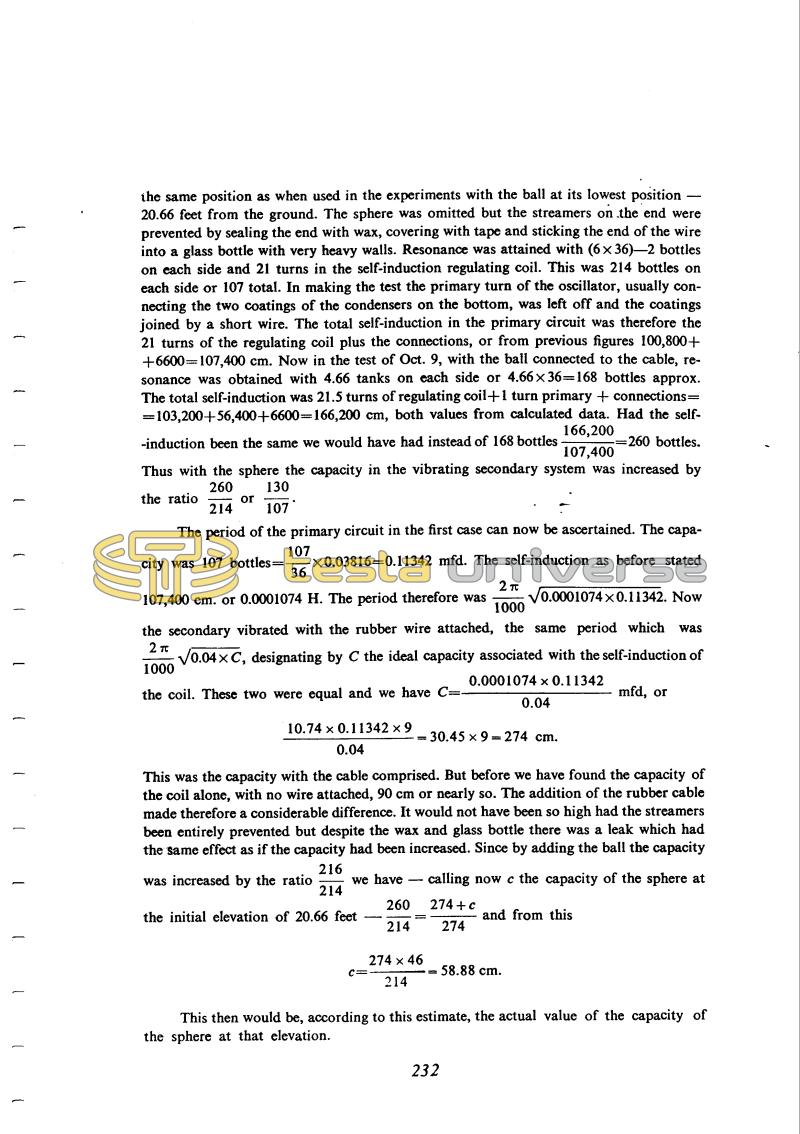
Nikola Tesla Books
the same position as when used in the experiments with the ball at its lowest position - 20.66 feet from the ground. The sphere was omitted but the streamers on the end were prevented by sealing the end with wax, covering with tape and sticking the end of the wire into a glass bottle with very heavy walls. Resonance was attained with (6 x 36) - 2 bottles on each side and 21 turns in the self-induction regulating coil. This was 214 bottles on each side or 107 total. In making the test the primary turn of the oscillator, usually connecting the two coatings of the condensers on the bottom, was left off and the coatings joined by a short wire. The total self-induction in the primary circuit was therefore the 21 turns of the regulating coil plus the connections, or from previous figures 100, 800 + 6600 = 107,400 cm. Now in the test of Oct. 9, with the ball connected to the cable, resonance was obtained with 4.66 tanks on each side or 4.66 x 36 = 168 bottles approx. The total self-induction was 21.5 turns of regulating coil + 1 turn primary + connections = 103,200 + 56,400 + 6600 = 166,200 cm, both values from calculated data. Had the self-induction been the same we would have had instead of 168 bottles !$ {{166,200 \over 107,400} = 260} !$ bottles. Thus with the sphere the capacity in the the vibrating secondary system was increased by the ratio !$ {260 \over 214} !$ or !$ {130 \over 107} !$.
The period of the primary circuit in the first case can now be ascertained. The capacity was 107 bottles !$ {= {{107 \over 36} \times 0.03816} = 0.11342 \text{ mfd.}} !$ The self-induction as before stated 107,400 cm. or 0.0001074 H. The period therefore was !$ {{2 \pi \over 1000} \sqrt{0.0001074 \times 0.11342}} !$. Now the secondary vibrated with the rubber wire attached, the same period which was !$ {{2 \pi \over 1000} \sqrt{0.04 \times C}} !$, designating by C the ideal capacity associated with the self-induction of the coil. These two were equal and we have !$ {C = {{0.0001074 \times 0.11342} \over 0.04}} \text{ mfd} !$, or
!$ {{{10.74 \times 0.11342 \times 9} \over 0.04} = 30.45 \times 9 = 274 \text{ cm.}} !$
This was the capacity with the cable comprised. But before we have found the capacity of the coil alone, with no wire attached, 90 cm or nearly so. The addition of the rubber cable made therefore a considerable difference. It would not have been so high had the streamers been entirely prevented but despite the wax and glass bottle there was a leak which had the same effect as if the capacity had been increased. Since by adding the ball the capacity was increased by the ratio !$ {216 \over 214} !$ we have - calling now c the capacity of the sphere at the initial elevation of 20.66 feet - !$ {{260 \over 214} = {{274 + c} \over 274}} !$ and from this
!$ {c = {{274 \times 46} \over 214} = 58.88 \text{ cm.}} !$
This then would be, according to this estimate, the actual value of the capacity of the sphere at that elevation.
232
October 21
In a thorough analysis of all details of his measuring apparatus, Tesla did not omit a determination of the parasitic inductance of the connections, by an interesting method which he says he used often in the New York laboratory. Varying the primary inductance and capacitance but keeping a constant frequency of the oscillator (as determined with an auxiliary resonant circuit), one has
Cp1(Lp1 + Lcon) = Cp2(Lp2 + Lcon)
where Cp1, Lp1 are the first and Cp2, Lp2 the second capacitance-inductance pair in the primary giving the same frequency. From this equation one can find the parasitic inductance of the connections Lcon, which Tesla denotes by x.
October 21
He studied all details of the measurement apparatus very carefully and Tesla did not neglect to calculate the parasitic inductances in the connections. On Oct. 21 he describes the interesting method (which he claims he frequently applied in the New York laboratory) by means of which the parasitic inductance is determined of the circuit element connections. By variation of inductance and capacitance in the oscillator primary at constant oscillator frequency, (which is determined by means of auxiliary circuits) it could be written: Cp1(Lp1 + Lcon.) = Cp2(Lp2 + Lcon.), where Cp1, Lp1 are the first pair and Cp2, Lp2 are the second pair of capacitances and inductances (of the coils) in the primary circuit.
The inductance of the connections is determined from this equation and that value Tesla designates by X. In the measurement circuit the resonant coil play the role of frequency indicator.
Tesla comes up with the first measured value of sphere capacitance. First he finds the value of the coil and supply connections capacitance, and then the capacitance of the coil, supply connections and the sphere. The measurement method is similar to the one of October 9.

